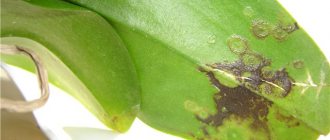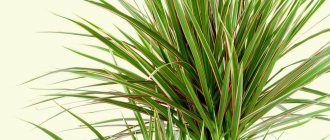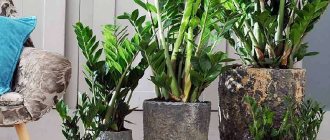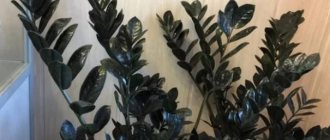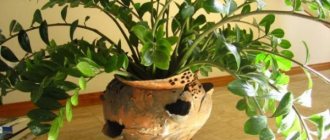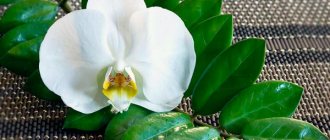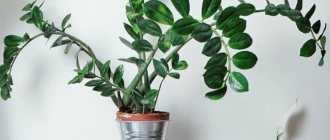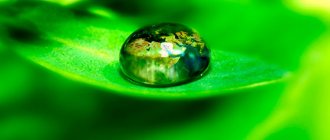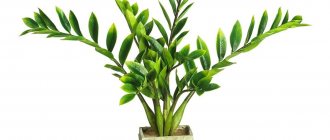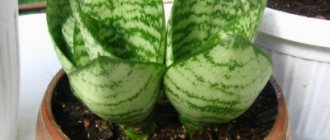Plants » Flowers
0
2763
Article rating
Kira Stoletova
The favorite indoor plant of Russian gardeners, Zamioculcas, came from hot Africa. Like all aroids, this flower is poisonous, and therefore requires a special approach to cultivation. If there are small children and pets in the house, its maintenance should be treated with extreme caution.
Is Zamioculcas dangerous - how does it affect humans and animals?
Is dollar tree poisonous or not?
For children
For young children, the plant poses a particular danger . It lies in the fact that babies tend to put things around them into their mouths. Such manipulation of zamioculcas leads to severe poisoning.
Swallowing a small piece of leaf by an adult will only lead to digestive upset. But if a child does this, he risks ending up in the intensive care unit.
This is explained by the fact that babies have not yet developed their immune system. In addition, the digestive organs do not yet contain a sufficient amount of enzymes that can neutralize toxic substances.
For cats and other pets
Pets often chew on indoor plants. If they eat even a small piece of zamioculcas, it will result in serious poisoning. Intoxication is especially dangerous for small animals .
Therefore, it is recommended to place the “dollar tree” in a place inaccessible to pets and children.
Why succulents are useful: beneficial properties for the home
The leaves of this plant are used to prepare remedies for the treatment of diseases of the musculoskeletal system.
Important! All parts of zamioculcas are poisonous, so only products for external use can be prepared from it.
The dollar tree is a natural filter ; it is recommended to install it not only at home, but also in hospitals, as well as in offices, especially in small rooms. At home, a flower can be placed in any room. The culture will bring the most benefit if you place a flowerpot with it in the bedroom. The dollar tree will make you sleep soundly and healthy. In addition, the culture can be placed in the room where many people often gather. Usually this is the kitchen or living room. The air in these rooms will become cleaner and fresher.
For a room larger than 8 square meters. meters of one flowerpot with a plant will not be enough.
By placing culture in offices, employee productivity and activity will significantly increase.
This is explained by a decrease in the amount of carbon dioxide in the air and its saturation with oxygen, which directly affects brain function. In addition, concentration improves.
The experience of doctors has proven that patients recover faster if a flowerpot with zamioculcas is placed in the room . A person with a chronic illness feels much better if a dollar tree is placed in his room, he becomes more cheerful and active.
In addition to purifying the air, the succulent can moisturize it. Therefore, such a flower is necessary for people suffering from respiratory diseases. The most important thing is to regularly remove dust from the surface of the flower and also spray it.
Symptoms of plant poisoning
If the dollar tree enters the body, the following symptoms are observed::
- nausea and vomiting;
- fever, seizures;
- diarrhea.
In particularly severe cases of poisoning, hallucinations and confusion may occur. Sometimes allergic reactions occur - runny nose, hives, lacrimation, rash, and wheezing. Chemical burns are manifested by redness of the skin. Getting toxic juice into the eyes leads to lacrimation, damage to the optic membrane and even conjunctivitis.
Attention! If pollen or zamioculcas juice gets into your eyes, you should urgently consult a doctor, as this may impair your visual acuity.
What danger does Zamioculcas pose?
Zamioculcas is considered a conditionally poisonous plant, like all representatives of the large aroid family. All parts of this plant are poisonous . The juice contained in the leaves and stem can lead to the following health disorders:
- persistent allergic reactions;
- skin rashes that closely resemble burns;
- intestinal disorders due to accidental ingestion of parts of the plant;
- visual impairment when juice gets into the mucous membranes of the eyes.
In addition, pollen from flowers is also harmful. This flower is especially dangerous for people who are prone to allergies .
The lifespan of Zamioculcas is from 5 to 10 years. The flower can reach one meter in height.
What to do if a child ate a flower?
The first thing you need to do is call an ambulance . After this, it is necessary to rinse the stomach. To do this, give a weak solution of potassium permanganate to drink. You need to rinse until the liquid from the stomach becomes clear and free of impurities.
The poisoned child is also given an absorbent. The most suitable ones are Enterosgel or Smecta. They envelop the walls of the stomach and prevent toxins from being absorbed into the digestive organs. The victim is then given a large amount of water or sweet tea.
Children under 5 years old can only have their stomach washed in a hospital.
Could it be fatal?
Fatal poisoning may well occur if the following conditions are met:
- Man has eaten too much of this vegetation.
- Parts of the zamioculcas were eaten by a small child who is light and has weak immunity.
- The victim has some chronic diseases.
A fatal outcome is possible only if first aid is not provided on time . This can happen if parents self-medicate and do not go to the hospital.
Precautionary measures
To prevent Zamioculcas from harming the health of others, it is recommended to adhere to the following rules :
- When cutting and replanting indoor crops, you only need to wear gloves. At the same time, do not touch the eyes and open areas of the body.
- After procedures with the flower, wash your hands with soap, more than once. Wipe your hands dry, preferably with a paper towel, which should then be thrown away.
- Place the dollar tree pot away from children and pets.
- If there are allergy sufferers in the house, it is better to avoid Zamioculcas altogether.
Zamioculcas is not called the dollar tree for nothing. This plant can attract good luck in financial matters. But at the same time, you should be very careful when handling culture so as not to harm yourself and others.
Care and reproduction
Its homeland is South Africa, zamioculcas is not afraid of high temperatures and prolonged lack of watering (it is better not to top up than to overfill and cause root rot). The dollar tree prefers diffused lighting and should be placed in south-facing windows. In summer, the flower is taken out onto the balcony or into the garden and watered often.
In winter, watering is reduced to 1-2 times a month . For propagation, cuttings or rooted leaves are used. Adult plants are replanted every 2 years . There is practically no need for fertilizer; if there is a desire, then 1-2 times a year they are fertilized with fertilizers suitable for succulents and cacti.
Young plants do not bloom. Unusually shaped flowers appear only on old dollar trees. The plant grows slowly; as it matures, its leaves begin to turn yellow and gradually fall off. Losing leaves is a natural process.
Signs associated with Zamioculcas
Many people know Zamioculcas under the interesting name “Women’s Happiness”. As popular rumor goes, it is this flower that somehow magically contributes to women’s happiness. But in order for this magical property to manifest itself fully, certain conditions must be met:
- The flower must be given as a gift.
- The magical properties appear only during the flowering period, and it blooms oh so rarely.
If you believe the same superstition, as soon as this succulent blooms, happiness will immediately knock on the house, and not just any kind, but a woman’s.
Another name for the flower is dollar tree. According to the teachings of Feng Shui, this flower is capable of attracting financial well-being into the home, just like the Crassula . But if the latter needs to bury coins in a pot to attract money, then Zamioculcas can simply be placed in your home.
Truth or myth: all about the toxicity of a house plant
An apartment without indoor flowers looks boring. It's like she's devoid of life. In addition to their interior function, such decorative elements, being living representatives of the flora, are designed to purify the air through photosynthesis, thereby helping a person feel more comfortable. It has been noted that some of the domestic plants have a psychological effect on their owners, stabilizing their psychosomatic state.
Many flower lovers would like to see zamioculcas in their home. Is this representative of indoor plants poisonous or not, and how can such a neighborhood affect human health?
65% of decorative flowers and flowerpots contain toxic substances in their juice, which pose a potential threat to the health of adults, children, and pets.
Almost all representatives of the Araceae family, including Zamioculcas, are harmful. The indoor plants you know belong to this large genus: spathiphyllum, dieffenbachia, scindapsus, philodendron, epipremnum and many others.
Let's figure out together whether Zamioculcas is poisonous or not for any living creatures.
Toxic sap circulates in all parts of the exotic plant. Don't panic and don't rush to get rid of your pet. Don't be afraid to touch leaves on the dollar tree or other parts of it.
The question “is Zamioculcas poisonous or not?” causes controversy.
As a result of the study, 10 out of 10 flower lovers surveyed say that growing such a plant at home did not bring them any discomfort. There was no deterioration in health, which means that the growing dollar tree did not affect the owners with its presence: allergic reactions did not appear, and cases of burns to the skin of the hands when carefully handling the flower were not recorded.
Do not forget that the sap of the plant is poisonous, so if you damage it, be careful with it. The flower itself does not emit toxic fumes that could cause intoxication in a living organism.
But! Since Zamioculcas is poisonous, it is therefore potentially dangerous.
The essence of the problem
Your cat does not have to ingest the plant to be poisoned, as some, such as croton, have a poisonous sap that is released when the animal chews the leaves and causes blisters in the mouth. However, it is necessary to adequately assess the risks. In some cases, the toxic effects on the animal's body can be serious and require the help of a veterinarian, but sometimes the cat can recover on its own. There is also no need to study long lists of house plants that can cause poisoning in cats. In real life, for most animals, most of them will be unattractive or uninteresting. For example, cyclamens often appear on such lists, but only the root of the plant is poisonous to pets and it is likely that very few cats will find cyclamen so attractive that it will cause them to dig up and eat enough of the roots to cause poisoning.
Important Tips
- Avoid buying houseplants that are known to be toxic to children or pets—if they are dangerous to children, they are likely to be dangerous to cats.
- If your cat has eaten a significant portion of any house plant, or even a small portion of a poisonous plant, or appears drooling or unwell after chewing the plant, contact your veterinarian immediately.
- Consider covering the base of your houseplants with silver foil or cling film - this will make it less interesting for your cat to dig up the plant's roots.
- Make sure your cat always has plenty of fresh water (cats often chew leaves to quench their thirst).
- Provide your cat with plenty of toys, regular feedings with an automatic bowl, or hang a bell outside your window to give your cat something to do while you're away. Cats often start chewing houseplants simply out of boredom.
The most common houseplants that are poisonous to animals are:
Flowers that cause allergies
Even house flowers that bloom beautifully on the windowsills of many apartments can be dangerous. This usually becomes clear when, when pruning or replanting, the plant secretes caustic juice from the cuts, which begins to corrode the skin on the hands.
Aglaonema
A houseplant with beautiful green leaves with white spots on the surface. It belongs to the decorative deciduous species, the flowers are small, dim, collected in inconspicuous rosettes.
Aglaonema contains poison in its leaves. May irritate skin, cause allergies, burns. But the berries formed after flowering are especially poisonous. If it enters the gastrointestinal tract, it causes severe intoxication, elevated body temperature and dehydration.
Geranium (pelargonium)
This plant has been grown on apartment windowsills for many years. It blooms beautifully with pink, red, burgundy flowers, the leaves have an original shape. This perennial feels good not only indoors, but also in open ground. Widely used to create traditional medicines and to repel insects.
The leaves of the flower emit vapors that enter the lungs when inhaled. These vapors contain essential oils, which can cause an asthma attack in allergy sufferers. When parts of the plant enter the body, poisoning occurs.
Monstera
A beautiful ornamental crop with an original flower-veil, inside of which there is a large spadix. It reaches enormous sizes, so it is often grown in floor pots not only in apartments, but also in offices. Monstera is especially loved by flower growers for its original carved large leaves.
Almost all species are not poisonous; only a few varieties contain caustic substances that, if eaten, can cause burning and irritation of the intestines. In rare cases, the plant causes reactions in the presence of individual sensitivity in humans.
Spathiphyllum
This beautiful bright flower with a white bud-veil and yellow cob, glossy large leaves has a second name - “female happiness”. It is credited with many magical as well as medicinal properties.
The plant is considered poisonous; the leaves and soft stems contain oxalic acid and calcium oxalates, which irritate the mucous membranes. If it comes into contact with the skin, stomach, mouth or eyes, the juice causes burns and irritation. If it gets into the lungs, it makes breathing difficult, which can cause an attack in asthmatics.
Scheffler
An ornamental plant with interesting umbrella leaves belongs to the Araliaceae family, like ivy and ginseng. 18 species are known. Tropical exotics today are grown indoors. Depending on the conditions, it can grow as a lush bush or a bonsai tree; thanks to its flexible woody shoots, it is suitable for weaving.
The berries and leaves are poisonous, but for severe intoxication you need to eat a lot of parts of the plant. In direct contact, shefflera juice can cause damage to the mucous membranes of the eyes or intestines; it is dangerous for the skin if there are wounds, scratches or abrasions on it.
Fatsia
The flower belongs to the Araliaceae family. It is an evergreen crop, growing mainly in the tropical regions of the Far East. It has beautiful wedge-shaped leaves, grows in the form of a tall shrub, reaching a height of 1.5 m. It is often used in landscaping garden plots, but fatsia is also grown indoors.
It is a mildly poisonous species and does not cause death, but may irritate the stomach when eating leaves, flowers or berries. With timely rinsing and taking an absorbent, the symptoms quickly disappear.
Ficus
A beautiful evergreen plant with original ovate-shaped leaves. Now it is grown in offices and apartments, valued for its unpretentiousness and variety of varieties.
The leaves, petioles and shoots of Ficus elastica contain milky sap containing 40% rubber. Allergic reactions may develop on unprotected areas of the skin, burns and blisters may appear.
When working with any poisonous crops, including those potentially hazardous to health, you need to use gloves, a protective mask that will cover the respiratory tract and nose, as well as long sleeves, making sure that the juice does not get on the skin
After finishing work, it is important to wash your hands and face thoroughly with soap.
